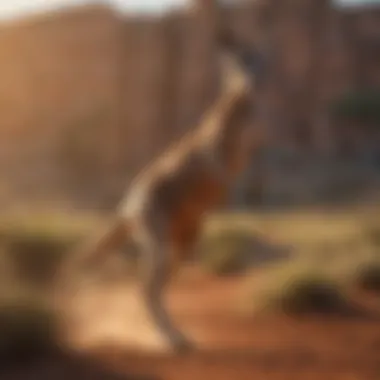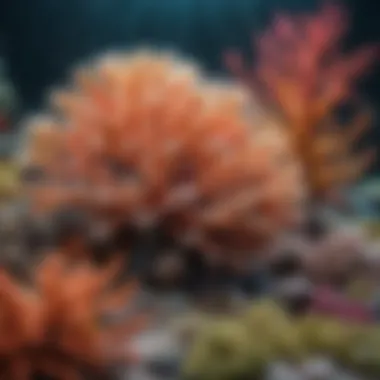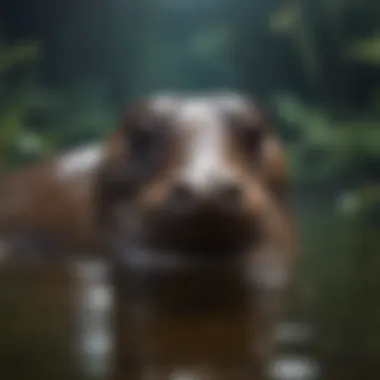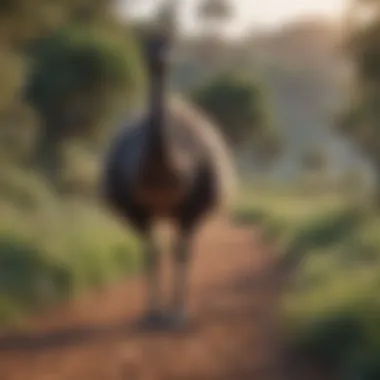Discovering Australia's Extraordinary Wildlife


Nature Topic Overview
Australia is home to some of the most unique and diverse wildlife in the world. This land is rich in ecosystems and species that are often not found anywhere else. From the famous kangaroo to the colorful corals of the Great Barrier Reef, Australia’s fauna captures the imagination. The adaptations of these creatures to their environments reveal much about survival in habitats that range from dense forests to arid deserts.
In this article, we will explore various Australian species, examining their fascinating traits and behaviors. Each creature plays a significant role in its habitat, contributing to the intricate web of life found across this vast continent. Understanding these animals helps foster appreciation for biodiversity, which is essential for conservation efforts.
Fun Facts and Trivia
Here are some exciting facts that might surprise you:
- Did you know that the platypus is one of the few mammals that lay eggs? This unique feature makes it an extraordinary creature in Australia.
- The emperor gum moth holds the title for having the largest wingspan of any moth in the world. It's an impressive sight!
- Coral reefs are often called the "rainforests of the sea" because they are filled with diverse marine life.
Visual tools like pictures and games can greatly enhance understanding. To learn more, kids can check out Wikipedia for colorful images and fun facts about their favorite animals.
Wildlife Explorations
Australia's diverse habitats support a wide variety of creatures. Here are some notable examples:
- Kangaroo: Perhaps the most iconic of Australian wildlife, kangaroos have strong legs that allow them to leap great distances. They thrive in grasslands and open forests.
- Koala: These gentle marsupials spend most of their lives in eucalyptus trees. They have a special diet that mainly consists of eucalyptus leaves, which helps them survive in their habitat.
- Great Barrier Reef species: The reef is home to thousands of species, including colorful fish, turtles, and corals. These creatures exhibit various behaviors, like the clownfish that lives in symbiosis with sea anemones for protection.
To engage young minds, consider incorporating quizzes. For example, "What does a koala eat?" or "How high can a kangaroo jump?" This type of interaction helps reinforce learning.
Environmental Awareness
Conservation is crucial for maintaining our planet's biodiversity. Many Australian species face threats from habitat loss and climate change. Young learners can help by:
- Learning about local wildlife and their habitats.
- Participating in clean-up activities in parks and beaches.
- Spreading awareness about endangered species.
By teaching children the importance of protecting nature, we can inspire a new generation of conservationists.
DIY Nature Activities
Engaging with the natural world can be fun and educational. Here are some activities that children can try:
- Nature scavenger hunt: Create a list of items to find in your garden or local park, such as specific leaves, flowers, or insects.
- Crafting: Collect items from nature like leaves or stones to create art. You could paint them or use them for a nature collage.
- Outdoor exploration: Go on short nature walks to observe wildlife. Encourage kids to take notes or draw what they see.
By learning about Australia's unique creatures, young readers can build a deep appreciation for nature, promote conservation, and foster a lifelong love of the environment.
Prelude to Australia's Biodiversity
Australia is home to an unparalleled array of wildlife. Its unique biodiversity stems from both its isolation and its varied landscapes. Understanding this biodiversity offers key insights into ecological balance and environmental stewardship. This section explores the diverse life forms that inhabit Australia, highlighting their significance in both ecological roles and cultural values.
Geographical Influence on Wildlife
Australia's geographic features profoundly influence its biodiversity. The continent has vast deserts, lush rainforests, and extensive coastlines. Each of these environments supports distinct species adapted to their surroundings. For example, in the arid outback, you find creatures like kangaroos, which have adapted to survive long periods without water. In contrast, the Great Barrier Reef serves as home for thousands of marine species, showcasing how different habitats foster diverse wildlife.
"Australia's separation from other landmasses has resulted in unique wildlife found nowhere else in the world."
This geographic isolation has allowed for the evolution of species that exhibit various unusual characteristics. Many Australian animals, such as marsupials and monotremes, are not seen in other countries. This uniqueness is a treasure trove for scientists and nature enthusiasts alike, illustrating the importance of geographical context in ecological diversity.
Importance of Unique Ecosystems
Unique ecosystems are crucial for numerous reasons. They provide vital services such as clean air and water, habitat for species, and resources for human use. The health of these ecosystems determines the overall health of the planet. For example, rainforests are often referred to as the lungs of the earth, filtering pollutants and producing oxygen.


In Australia, protecting unique ecosystems helps ensure the survival of endangered species, such as the critically endangered Northern Hairy-nosed Wombat. Loss of any ecosystem threatens the delicate balance of wildlife within it. Therefore, learning about these ecosystems becomes imperative for future conservation efforts.
In summary, understanding Australia's biodiversity through its geographical influence and unique ecosystems deepens the appreciation for the creatures that inhabit the continent. Building awareness is crucial for the ongoing conservation of these remarkable environments.
Remarkable Mammals of Australia
Australia is home to a wealth of unique mammals that stand out for their distinctive characteristics. Many of these species exhibit fascinating adaptations suited to the diverse habitats found across the continent. Understanding these mammals not only enriches our knowledge about Australia's wildlife but also emphasizes the importance of preserving their ecosystems. The evolution of these creatures reflects their adaptations to the Australian environment, showcasing how isolation can lead to unexpected traits and behaviors.
One remarkable aspect is the presence of marsupials, which give birth to relatively undeveloped young that continue to grow in pouches. This is a key survival strategy in a land of varied climates, from arid deserts to lush forests. By exploring these remarkable mammals, readers can gain insight into biodiversity, ecology, and the challenges these species face in a changing world.
The Platypus: Nature's Riddle
The platypus is one of the most peculiar mammals in the world. It possesses features atypical to mammals, such as a duck-like bill, webbed feet, and the ability to lay eggs. Native to eastern Australia, the platypus is an excellent example of evolutionary adaptation. This animal lives in freshwater rivers and streams, using its bill to hunt for small invertebrates while submerged.
The platypus has electroreceptors in its bill that help it detect prey in murky waters. This sensory ability is rare among mammals but essential for survival. Sadly, habitat destruction and pollution pose serious threats to their populations. Protecting this species and its environment is crucial for maintaining the balance of its ecosystem.
Koalas: The Tree-Huggers
Koalas are often regarded as a symbol of Australia. These furry creatures spend most of their lives in eucalyptus trees, a necessity due to their specialized diet. Eucalyptus leaves are low in nutrients, leading koalas to consume large quantities to meet their energy needs. Their slow metabolism helps them conserve energy, making them sleep up to 18 hours per day.
Koalas are also social animals, often seen in groups. However, they face threats from urban development and climate change, which impact their habitats. Conservation efforts are essential to ensure their survival in the wild, emphasizing the importance of education on protecting these beloved animals.
Wombats: The Burrowing Beasts
Wombats are stout, burrowing marsupials native to Australia. Known for their strong limbs and large claws, these creatures are excellent diggers. They create extensive tunnel systems underground, which serves as protection from predators and extreme weather. Wombats are herbivores and primarily feed on grasses, roots, and bark.
Their unique design includes a backwards-facing pouch that prevents dirt from entering while they dig. This is quite an extraordinary feature. However, wombat populations are declining due to habitat destruction and disease. Efforts to study and conserve these fascinating creatures are essential for maintaining their role in the Australian ecosystem.
Fascinating Birds of Australia
Australia is known for its diverse and unique wildlife, and its birds are no exception. These avian creatures play a crucial role in their ecosystems, from pollination to seed dispersal. Understanding these birds contributes to our appreciation of Australia’s natural heritage. Highlighting their unique traits and behaviors can inspire both children and adults to engage with nature and consider conservation efforts.
The Emu: Flightless Wonder
The emu is one of Australia's most iconic birds. Standing up to two meters tall, it is the second-largest bird in the world after the ostrich. What makes the emu fascinating is not just its size, but also its flightless nature. Although unable to soar through the skies, the emu is a strong runner. It can reach speeds of up to 50 kilometers per hour in short bursts. This speed is vital as it helps evade predators like the dingo.
Emus have a unique lifestyle. They are nomadic, often traveling long distances in search of food and water. Their diet mainly consists of plants, seeds, fruits, and insects. By feeding on these, they help maintain the health of their habitats, making them important to the ecological balance. As a distinctive Australian bird, the emu represents the country’s unique wildlife and the adaptations that help animals survive in diverse environments.
The Lyrebird: Master Mimic
The lyrebird is often celebrated for its remarkable ability to mimic natural and artificial sounds. It is considered one of the best mimics in the animal kingdom. From chainsaws to car alarms, the lyrebird can imitate a wide range of noises, showcasing its adaptive skills. This talent is primarily demonstrated by males during mating season as they perform elaborate displays to attract females.
Two species are commonly recognized: the superb lyrebird and the Albert's lyrebird. The superb lyrebird is especially notable for its striking tail feathers, which are shaped like a lyre. This intricate plumage adds to the spectacle when it displays during its courtship rituals, making it a true masterpiece of evolution.
The connection between sound and survival is apparent in the way lyrebirds use their vocal skills. It is not solely for attracting mates, but also for communicating with others in their habitat, showcasing their intelligence and adaptability.
Cockatoos: Bright and Vocal Residents
Cockatoos are another group of fascinating birds found across Australia, known for their striking crests and social behavior. There are several species, including the sulphur-crested cockatoo and the umbrella cockatoo. Cockatoos are incredibly intelligent and curious, often seen in large flocks. Their loud calls and vocalizations resonate throughout the Australian bush, serving various social functions.
Cockatoos are highly social animals. They live in family groups and engage in playful behaviors. Their diet consists of seeds, nuts, and fruit, making them critical for seed dispersal, which aids plant regeneration. The relationship between cockatoos and their environment is symbiotic, emphasizing the interconnectedness of ecosystems.
The bright colors and social nature of cockatoos make them a favorite among birdwatchers and nature enthusiasts. They also bring attention to the importance of protecting their habitats, as many species face threats from habitat loss and illegal trapping.
The presence of unique birds like the emu, lyrebird, and cockatoo underscores the significance of Australia’s avian biodiversity.


Strange Reptiles of Australia
Australia is known for its fascinating and often bizarre reptiles. Their unique adaptations and behaviors reflect the continent’s diverse ecosystems. Reptiles play a crucial role in maintaining environmental balance. They help control insect populations and contribute to the food web. Understanding these reptiles is essential not only for appreciating biodiversity but also for promoting conservation efforts.
The Thorny Devil: Nature's Armor
The Thorny Devil is one of the most recognizable reptiles in Australia. Its name comes from the distinctive spikes covering its body. These spikes serve a dual purpose. They act as a defense mechanism against predators, making it harder for them to eat. Additionally, the Thorny Devil has a unique way of drinking. It collects dew and rainwater on its skin and channels it to its mouth. This adaptation is vital in arid areas, helping it survive in harsh conditions. The Thorny Devil is a perfect example of how evolution has shaped Australian wildlife.
The Inland Taipan: The Most Venomous Snake
The Inland Taipan is renowned for being the most venomous snake on Earth. Its venom is extremely potent, capable of killing a human in under an hour. However, this snake is very reclusive and prefers to avoid human interaction. It inhabits the arid regions of Australia, primarily in Queensland. The Inland Taipan has distinctive color patterns that vary with the season. In cooler months, it appears darker, while in warmer months, its color lightens. Despite its reputation, there have been no recorded fatalities from its bite due to its elusive nature.
Dragons and Monitors: Lizard Diversity
Lizards in Australia are incredibly diverse, with species such as goannas and bearded dragons standing out. These reptiles inhabit various environments, from deserts to forests. Goannas, for example, are powerful predators and can grow quite large. They play a vital role in controlling rodent populations. Bearded dragons are particularly popular among pet owners due to their docile nature. These lizards display a fascinating behavior known as "beard inflation," where they puff up their throat when threatened. This display serves to make them appear larger to potential predators.
Interestingly, many lizards can regenerate their tails after losing them, a trait that provides an escape strategy from predators.
In summary, the strange reptiles in Australia showcase the extreme adaptability of wildlife in various habitats. Their unique features and behaviors enhance our understanding of evolution and survival.
Bizarre Aquatic Life Forms
Aquatic life in Australia is unique and remarkable. The oceans, rivers, and lakes harbor many bizarre creatures that exhibit fascinating adaptations. These life forms play crucial roles in their ecosystems. Learning about these unusual aquatic beings broadens our understanding of biodiversity. This section explores three key aquatic species that highlight Australia's extraordinary marine diversity.
The Box Jellyfish: A Floating Menace
The Box Jellyfish is one of the most dangerous creatures in the ocean. Its translucent body and box-like shape make it a unique sight. Each jellyfish has long tentacles that contain venom. This venom is deadly to humans and can cause extreme pain. Despite its danger, the box jellyfish is an important part of the marine food web. Many animals, like sea turtles, eat jellyfish. Understanding this creature’s role is vital for grasping the complexities of marine ecosystems.
"The box jellyfish shows how beautiful yet dangerous ocean life can be."
The Leafy Seadragon: Masters of Disguise
The leafy seadragon is one of Australia’s most striking marine creatures. It looks like a piece of seaweed, thanks to its leaf-like appendages. This incredible mimicry helps it hide from predators. Leafy seadragons are closely related to seahorses and are found along the southern coasts of Australia. They feed mainly on small shrimp and other tiny marine animals. Their unique adaptations highlight the importance of blending into the surroundings for survival. This creature reminds us of the wonders of evolution in aquatic habitats.
Great Barrier Reef: An Ecosystem of Diversity
The Great Barrier Reef is a treasure of biodiversity. It is the largest coral reef system in the world, stretching over 2,300 kilometers. The reef is home to thousands of marine species, including fish, corals, and mollusks. Each creature plays a role in maintaining the health of the reef. However, the reef faces threats from climate change and pollution. Protecting this ecosystem is crucial not only for Australia but for the planet as a whole. Educating ourselves about the reef can help inspire conservation efforts.
In summary, the bizarre aquatic life forms of Australia reflect the intricate bond between species and their environments. Understanding their roles paves the way for appreciating biodiversity and the importance of conservation efforts.
Unusual Insects and Arachnids
Insects and arachnids play a crucial role in Australia's ecosystems. These creatures, often overlooked, are essential for pollination, decomposition, and as part of the food web. Their unique adaptations help them thrive in various Australian habitats. Recognizing their significance contributes to a greater appreciation of biodiversity.
The Bull Ant: Fearsome Predators
The Bull Ant, known for its size and fierce behavior, is one of the most interesting insects in Australia. They can grow quite large, with some species reaching up to 4 centimeters in length. Their most notable feature is their powerful sting. A Bull Ant's sting is painful, which serves as an effective defense mechanism against predators.
Bull Ants are primarily nocturnal hunters. They forage for food at night, mainly preying on other insects. Their keen sense of smell helps them locate their prey quickly. This predatory behavior keeps the insect population in check, indicating their role in the ecosystem.
The Christmas Beetle: Seasonal Spectacles
The Christmas Beetle is a colorful insect that emerges during the Australian summer, particularly around December. Their shiny, vibrant shells make them a delightful sight, especially for children. These beetles feed on eucalyptus leaves and are significant for the pollination of certain plants.
Christmas Beetles have a unique life cycle. The larvae develop in the ground, feeding on decaying organic material. This process aids in nutrient recycling in the soil. Their appearance marks the festive season for many families, making them part of cultural celebrations.


The Sydney Funnel-Web Spider: Venomous Mystery
The Sydney Funnel-Web Spider is one of the most well-known and potentially dangerous arachnids in Australia. They inhabit moist environments, often found in gardens and bushland. Their funnel-shaped webs are intricate and provide shelter while also serving as traps for unsuspecting prey.
Unlike many other spiders, the Sydney Funnel-Web is aggressive when threatened. Their venom is highly toxic, but antivenin has been developed, significantly reducing fatalities. Understanding their habitat and behavior is essential for safety, especially in urban areas. Their role in controlling insect populations also highlights their importance in the ecological balance.
"Insects and arachnids are often the backbone of healthy ecosystems. Understanding their role helps in conservation efforts."
Overall, learning about unusual insects and arachnids enriches our understanding of Australia’s unique fauna. From the fierce Bull Ant to the colorful Christmas Beetle and the mysterious Sydney Funnel-Web Spider, each species has its place in the intricate web of life.
Endangered Species and Conservation
The discussion about endangered species and conservation is vital in understanding Australia's unique wildlife. This country is home to some of the world's most distinct creatures, many of which face severe threats. Recognizing why these species are endangered is crucial to fostering an environment that supports their survival. Furthermore, protecting these species means preserving a piece of Australia's natural history for future generations.
Identifying Threatened Species
Knowing which species are threatened is the first step in conservation. In Australia, we have animals such as the Leadbeater's possum and the Western Swamp Tortoise on the verge of disappearing. There are also plants like the Northern Corroboree Frog.
Monitoring these species helps scientists understand what they need to survive. This identification is done through surveys, habitat assessments and sometimes by using technology like GPS tracking. By identifying these threatened species, we can highlight their status and develop necessary actions to support their recovery.
Impact of Human Activities on Wildlife
Human actions play a large role in the status of many Australian species. Urban development leads to habitat loss. For instance, cities often expand into areas that serve as homes for animals. This disrupts their natural habitats, making it hard for them to find food or shelter.
Also, pollution from various sources affects both land and marine life. Chemicals and waste can poison animals, causing decreased populations. Agriculture can also encroach on wildlife habitats, leading to the endangerment of countless species.
A significant realization is that people's choices matter. When buying products, many must consider their sources and impacts on wildlife. Responsible practices in farming, energy consumption, and waste disposal can make a difference.
Conservation Efforts: Protecting Australia's Natural Heritage
The ongoing conservation efforts are targeted at protecting these endangered species and restoring their habitats. Organizations such as the Australian Conservation Foundation and the World Wildlife Fund work tirelessly to enact meaningful change. These efforts include:
- Habitat Restoration: Replanting native species, creating wildlife corridors, and restoring wetlands are some of the ways planners can support wildlife habitats.
- Legal Protections: Laws aimed at protecting endangered species help ensure their safety. In Australia, the Environment Protection and Biodiversity Conservation Act is crucial for conservation actions.
- Education and Outreach: Programs educating the public about endangered species serve a dual purpose. They raise awareness and encourage community involvement in various conservation initiatives.
"Understanding and preserving our natural heritage is a responsibility we all share."
Culmination: Appreciating Australia's Wildlife
Australia is home to a remarkable array of wildlife that requires our appreciation and involvement. The conclusion of this article emphasizes the need to understand and protect these unique creatures. By recognizing the diversity of Australia's wildlife, we can nurture a deeper respect for the environment.
Education plays a crucial role in fostering this understanding. When young learners know about different species and their habitats, they begin to realize how their actions impact nature. This knowledge not only empowers children but also encourages them to become advocates for wildlife protection. People who are informed are more likely to engage in conservation initiatives. Community involvement and awareness are essential for preserving Australia’s unique ecosystems.
There are numerous benefits to appreciating wildlife. For example, it fosters curiosity about nature among children. This curiosity leads to exploration and learning, which are vital for their development. Furthermore, including wildlife education as part of school curriculum can help foster a sense of responsibility. Children learn to care for the natural world, which is imperative for future generations.
In summary, appreciating Australia’s wildlife is more than just an enjoyable experience. It has significant implications for conservation efforts and reflects our respect for the planet.
The Role of Education in Conservation
Education is a foundational aspect of wildlife conservation. It provides the necessary information that shapes our understanding of various species. Schools, museums, and even parks offer valuable resources for learning. They help children comprehend the delicate balance within ecosystems. Knowledge gained through education can spur children to take action against environmental threats. This may include participating in clean-up activities or advocating for protective legislation.
Programs targeted at young audiences can engage them. For instance, interactive workshops and nature walks can be effective. These programs allow children to directly observe wildlife in their habitats. When children learn firsthand about the challenges faced by these species, they may feel more motivated to get involved.
Moreover, integrating technology in education can enhance learning. Virtual reality and mobile apps can transport children to Australia’s stunning habitats. This immersive experience adds depth to their understanding, making it memorable and impactful.
Encouraging Respect for Nature
Encouraging respect for nature is vital for sustainable interaction with the environment. Once children develop an appreciation for wildlife, it becomes easier to instill a sense of respect. This respect extends to all forms of life, regardless of their size or significance.
Several key factors can enhance this respect.
- Active Participation: Engaging in local conservation efforts can foster a sense of ownership among children.
- Respectful Observation: Teaching children how to observe wildlife without disturbing it is crucial.
- Storytelling: Sharing stories about animals and their struggles can evoke empathy.
Through these elements, respect for nature can become a lifelong value. Children learn that their actions matter, and they have a role to play in preserving biodiversity. This empowered mindset can lead to positive changes at both the local and global levels.







